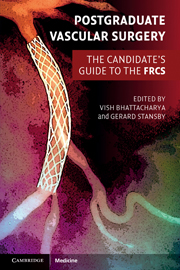Book contents
- Frontmatter
- Contents
- List of contributors
- Preface
- Section 1 Final FRCS vascular clinicals
- Section 2 Final FRCS vascular topics
- 1 Vascular risk factors and their management
- 2 Management of acute limb ischaemia
- 3 Chronic lower limb ischaemia, critical ischaemia and the diabetic foot
- 4 Endovascular and surgical options for peripheral revascularisation
- 5 Abdominal aortic aneurysms
- 6 Thoracic, thoracoabdominal and suprarenal aortic aneurysms
- 7 Aortic dissection
- 8 Popliteal artery aneurysms
- 9 Femoral artery aneurysms
- 10 Carotid, subclavian and vertebral disease
- 11 Diagnosis and management of thoracic outlet syndrome
- 12 Diagnosis and management of hyperhidrosis
- 13 Chronic mesenteric ischaemia
- 14 Acute ischaemic colitis
- 15 Vascular trauma
- 16 Indications and management of lower limb amputation
- 17 Leg swelling and lymphoedema
- 18 Varicose veins and chronic venous insufficiency
- 19 Management of deep vein thrombosis
- 20 Infection in vascular surgery
- 21 Vascular malformations
- 22 Vasospastic disorders and vasculitis
- 23 Critical care considerations and preoperative assessment for general and vascular surgery
- 24 Access surgery
- 25 Basic outline of solid organ transplantation
- Index
- References
3 - Chronic lower limb ischaemia, critical ischaemia and the diabetic foot
- Frontmatter
- Contents
- List of contributors
- Preface
- Section 1 Final FRCS vascular clinicals
- Section 2 Final FRCS vascular topics
- 1 Vascular risk factors and their management
- 2 Management of acute limb ischaemia
- 3 Chronic lower limb ischaemia, critical ischaemia and the diabetic foot
- 4 Endovascular and surgical options for peripheral revascularisation
- 5 Abdominal aortic aneurysms
- 6 Thoracic, thoracoabdominal and suprarenal aortic aneurysms
- 7 Aortic dissection
- 8 Popliteal artery aneurysms
- 9 Femoral artery aneurysms
- 10 Carotid, subclavian and vertebral disease
- 11 Diagnosis and management of thoracic outlet syndrome
- 12 Diagnosis and management of hyperhidrosis
- 13 Chronic mesenteric ischaemia
- 14 Acute ischaemic colitis
- 15 Vascular trauma
- 16 Indications and management of lower limb amputation
- 17 Leg swelling and lymphoedema
- 18 Varicose veins and chronic venous insufficiency
- 19 Management of deep vein thrombosis
- 20 Infection in vascular surgery
- 21 Vascular malformations
- 22 Vasospastic disorders and vasculitis
- 23 Critical care considerations and preoperative assessment for general and vascular surgery
- 24 Access surgery
- 25 Basic outline of solid organ transplantation
- Index
- References
Summary
Key points
Peripheral arterial disease (PAD) affects approximately 30% of the adult population
PAD is a powerful marker of cardiovascular risk and the risk is related to the severity of the PAD
Risk factor management has been proven to reduce cardiovascular risk but many patients do not receive adequate treatment
The optimum treatment to improve walking in patients with intermittent claudication is best medical treatment, supervised exercise and angioplasty
Angioplasty and surgery appear to be equivalent in treating critical limb ischaemia (CLI). However, angioplasty is cheaper due to reduced length of hospital stay
Diabetic foot complications are a common cause of hospital admission and often precede amputation. The majority of amputations in the UK are carried out in patients with diabetes
Patients with diabetes should be screened annually for neuropathy and PAD
Multi-professional team approach to the management of diabetic foot complications can reduce amputation rates
Epidemiology
Atherosclerotic arterial disease affecting the legs, peripheral arterial disease (PAD), is very common. In many patients it is asymptomatic but commonly the first manifestation of PAD is pain in the leg on walking, intermittent claudication. In some patients the blood supply to the leg becomes further reduced to a level when pain is experienced at rest and ulceration and gangrene occur (critical limb ischaemia, CLI). In the Edinburgh Artery study it was found that 4.5% of men and women over 55 years of age had intermittent claudication but a further 25% had evidence of asymptomatic disease.
- Type
- Chapter
- Information
- Postgraduate Vascular SurgeryThe Candidate's Guide to the FRCS, pp. 58 - 71Publisher: Cambridge University PressPrint publication year: 2011



